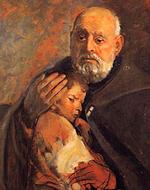Catholic Recipe: Beranek
Also Called: Easter Lamb Cake
Soon will come Green Thursday When we shall bake the Lamb; We shall eat Judases farina, And three spoonfuls of honey
is what an old Czechoslovak folk song says about Zeleny Ctvrtek, or Green Thursday, the Thursday before Easter. Green Thursday is important, for on this holy day when Our Lord traditionally washed the disciples' feet, humble people in many places still cling to time-honored customs and ancient folk beliefs.
Mothers waken the children early and hustle them off to bathe in brooks, so the youngsters will be "cured of laziness." Few of the little ones are lazy on this day. A quick dip in the icy water and they are racing home to the traditional holiday breakfast of "Judases" and honey. Judases-cakes molded to look like twisted ropes-suggest the fate of Judas, the Betrayer, who "went and hanged himself" in remorse, after he had identified Jesus to His enemies. Honey is a preventive against disaster; for it is believed to be a potent antidote against serpent stings.
Green Thursday is the day when housewives traditionally bake beranek, a white cake made in a lamb-shaped mold and served on Easter Sunday. Beranek, which symbolizes the Lamb of God, occupies the place of honor on the holiday table. And to add a touch of realism, the housewife often knots a blue satin ribbon with a small bell around the pastry creature's neck and ties it in a bow beneath the chin.
In Czechoslovakia peasants carry to church baskets containing marvelously painted Easter eggs and portions of the holiday foods for the priest's blessing. The women adorn the baskets charmingly with flowers and ribbon streamers, and cover the food with embroidered linen cloths. After the priest pronounces the joyous words, "Christ is risen!" families hurry home to partake of the many delicacies Lent has denied them.
The Easter dinner includes roast lamb, or often a ham. Czechs always slice the ham across the top, with the grain, and surround it with boiled potatoes and parsley butter. They pile a basket high with boiled eggs decorated in traditional designs. The festal table is gay with embroidered peasant linens, early spring flowers, and branches of pussywillow. Mazanec, a rich yeast bread made with almonds and raisins, and bakovka, a round coffee bread with a hole in the center, accompany the numerous cups of coffee. Then there is the beautiful lamb cake for dessert.
Lamb cake molds are available in many hardware and department stores throughout the country. The cast-iron and cast-aluminum molds are the most expensive and the best, but the light sheet-aluminum forms cost less and are perfectly satisfactory for home use.
DIRECTIONS
Sift together flour, salt, baking powder, and sugar. Beat egg whites until they stand up in peaks but are not dry. Set aside. Cream butter until soft and fluffy, add dry ingredients, milk and flavoring, and beat thoroughly. Fold in egg whites last of all.
With pastry brush and vegetable shortening grease both sides of mold. Flour. Pour batter into face half of mold. Be sure that each ear is filled and insert a toothpick in nose for added reinforcement. Cover with the back side of mold, lock edges and wire together the two sides for greater security. Place mold face down on cookie sheet and bake in moderate oven (370° F.) for 50-60 minutes. Let cool 5 minutes before removing from pan. Take off back side first. Then loosen cake from sides and remove carefully.
Set lamb upright on cake rack until cool. Spread frosting over cake and sprinkle over with grated coconut. Use raisins or currants for eyes, a strip of candied cherry for mouth, and tie a blue satin ribbon with a bell around neck.
Recipe Source: Feast-Day Cakes from Many Lands by Dorothy Gladys Spicer, Holt, Rinehart and Winston, 1960





